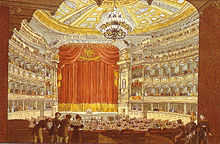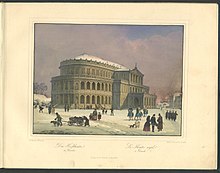Royal Court Theater Dresden


The Royal Court Theater Dresden (also known as the Altes Hoftheater ) was the predecessor of today's Semperoper , which served between 1841 and 1869 as a house for opera and drama in the royal Saxon residence city of Dresden .
history
From 1838 to 1841, the architect Gottfried Semper built a representative opera house, the new Royal Court Theater, as a successor to the previous Morettian court theater. He took the forum plan devised by Matthäus Daniel Pöppelmann as the basis for his well thought-out urban development solution. The opening took place on April 13, 1841 with Carl Maria von Weber's jubilee overture and Johann Wolfgang von Goethe's drama Torquato Tasso .
In the following years Richard Wagner was Kapellmeister here and brought out various premieres of his musical dramas with Wilhelmine Schröder-Devrient and Joseph Tichatschek , among others : Rienzi , Der Fliegende Holländer and Tannhäuser .
The rotunda in the forms of the Italian early Renaissance was praised as one of the most beautiful European theaters. Semper's first theater building was considerably closer to the castle than his second opera house, which still exists today; in front of the opera the forerunner of today's theater square was laid out in 1840 .
The respected Dresden clockmaker Friedrich Gutkaes was commissioned in 1838 to construct a clock that should be easy to read from all ranks. This clock from the Gutkaes art clock factory is now one of the most historically significant of its kind.
On September 21, 1869, this theater building was completely destroyed in a fire due to carelessness in repair work. After the disaster, games continued for a few years in an interim theater, the so-called "Shack". Meanwhile, Semper was working on new construction plans for the second royal court theater, today's Dresden Semperoper.
The Dresden court councilor Wilhelm Lesky set up remains of the burned down first Semper Opera as a picturesque arrangement of ruins on his villa estate in Kötzschenbroda . These spoils are no longer preserved today. In contrast, the so-called Rietschel gable , which can be seen today at the Burgtheater on the Ortenburg in Bautzen , was preserved. This group of figures created by Ernst Rietschel with the title “Allegory of Tragedy” was originally installed on the north wall of the Dresden court theater, but was no longer used in the new construction of the opera house.
Hofkapellmeister
Important conductors worked at the Dresden court opera at that time:
- Carl Gottlieb Reissiger (1798-1859)
- Richard Wagner (1813-1883)
- Ernst von Schuch (1846–1914)
Singers (selection)
World premieres in this house (selection)
- Richard Wagner: Rienzi , the last of the tribunes , October 20, 1842
- Heinrich Marschner / Heribert Rau : Emperor Adolph von Nassau , January 5, 1845
- Richard Wagner: The Flying Dutchman , January 2, 1843
- Richard Wagner: Tannhäuser and the Singers' War at Wartburg , October 19, 1845
- Carl Gottlieb Reissiger / Hans-Georg Kriete : The shipwreck of the Medusa , August 16, 1846
- Anton Rubinstein / Julius Rodenberg : Feramors , February 24, 1863
For the inauguration in 1841
Ida von Lüttichau , wife of General Manager Wolf Adolf August von Lüttichau , reports in a letter:
“The theater can no longer be called beautiful, it is perfect: it is not just splendor, taste, grace, but a total = impression of something artistically great, perfect, sublime: every detail belongs to the whole, such harmony in all Divide, so complete penetration of painting, architecture, decoration of every kind that one cannot emphasize anything individually. So the tone is just as moderate and muffled as it is resounding, and I never thought of such a correct measure of the tone; The lighting, too, is very brilliant, but is so distributed that the highest brilliance of the decorations does not stand alone or has a dazzling effect. If it is this perfection of the exterior that leaves no room for the intellectual art of acting and pushes it to the ground, I have never seen a work done so dead as Tasso did that evening. The setting is, I think, too great for the drama; These spaces are more suitable for opera and fill them up with the masses, instead of the individual artist seldom reaching the height of his Cothurn through the power of his genius, and everything that does not fully resonate in this work of art falls to the ground straight away ; there is something wonderful about the fact that the most favorable effect of all circumstances had to come together in order to produce this unity. . . A talented genius like Semper, whose conception is the great whole: practical, experienced painters like the French, a poetic painter like Huebner , a mechanical talent like Blochmann , and a fine, noble sense of beauty like that of my husband (connected with an iron energy and power of will), which is not based on the intellectual as well as on the sense of order, and in proportion and harmony, all of this had to unite in order to give the whole this very shaping, so that it is called the most brilliant can become what our present time has to show. You can imagine that this theatrical question was almost ecclesiastical to me, and such an uplifting mood can only have a beneficial effect. As always, Lüttichau was noble and simple, where great things are important in sorrow and joy. "
Facade after the theater square
literature
- Heinrich Ferdinand Mannstein: Memories of the electoral and royal court music in Dresden in the 18th and 19th centuries: According to secret papers and communications. Contains : Life pictures of Joh. Mieksch and his students: Alphonso Zesi, Bergmann , Schröder-Devrient , Agnes Schebest , Naumann, Carl Maria v. Weber , Morlacchi , Benelli etc. Heinrich Mattes, Leipzig 1863 MDZ Reader
- Michael Heinemann / Hans John : The Dresden Opera in the 19th Century , Laaber-Verlag, Regensburg 1995, ISBN 3-89007-310-7 .
- Robert Nitzsche: The fire of the royal court theater in Dresden on September 21, 1869 . Dresden 1869 ( digitized version ).
Web links
Individual evidence
- ↑ Five-minute clock of the Semperoper ( page no longer available , search in web archives ) Info: The link was automatically marked as defective. Please check the link according to the instructions and then remove this notice.
- ↑ Petra Bern / Mondrian W. von Lüttichau (ed.): Truth of the soul - Ida von Lüttichau (1798-1856). Supplementary volume (Berlin 2015, pages 67–68) pdf
- ↑ Alfonso Zesi (May 17, 1799 in Milan - 1861 in Milan). Bass singer a. a. in Dresden.
Coordinates: 51 ° 3 ′ 16.2 ″ N , 13 ° 44 ′ 6.6 ″ E





